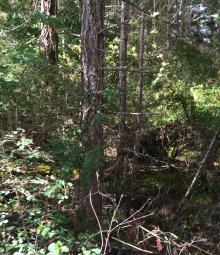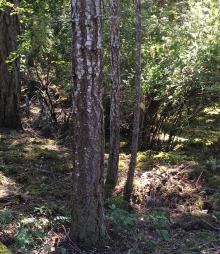Resources
Education
A wildland/urban interface is defined as a ‘geographical point where the diverse values of the wilderness and urban development meet. In the interface, structures and vegetation are sufficiently close that a wildfire may spread to structures or a structural fire may ignite trees and vegetation.’
Many of us, me included, live in a wildland/urban interface. With each of the ever-growing list of destructive fires - Okanagan Mountain, Lesser Slave Lake,
numerous California wildfires, the BC fires of 2015 and the granddaddy of them all Fort Mac 2016, followed by 2017 , & 2021 disasters and evacuations, lessons are learned. Homes survive when all around them are lost. It is apparent that we home owners can improve our chances of having our homes survive a wildfire.
The BC FireSmart Manual available online as a pdf file and has information on fire smart landscaping techniques, construction methods and general maintenance for those living in an interface.
The remainder of this article is directed to fire smart landscaping methods and plant material selections.
Fire resistant plants tend to have
- moist supple leaves
- accumulate minimal dead vegetation
- have a water-like sap that produces little odour
- and have small amounts of sap or resin
On the other hand highly flammable plants have
- aromatic leaves or needles
- accumulate fine, dry, dead material
- have resin or oils
- and/or loose flaky or papery bark
Unsightly and unsafe
Fire smart strategies address the fact that fire can spread by sparks/embers,
radiant heat and direct flame. In an interface the area around your home is
divided into three priority zones, zone 1 is usually the first 10 meters round the
house, zone 2 the next 20 and zone 3 the next 70 meters or the property line.
Slopes affect the ease of fire spread and thus can affect the size of these fire
smart zones.
The goal in zone 1, 10 meters around your home, is to create a fire resistant
zone free of all material that could easily ignite in a fire. Low-density, fireresistant
plants and shrubs are recommended. Conifers should not be grown
within 10 meters of your house. They are not only highly flammable but also burn
hot enough to damage and even ignite a nearby building. Healthy well
maintained deciduous trees are much more fire resistant. Clear all highly
combustible materials including woody debris, bark mulch and pine needles.
Mulching with gravel or decorative crushed rock are fire smart alternatives.
Zone 2 is from 10 to 30 meters from your house. Strategies in zone 2 are
directed to controlling the intensity of a fire. Surface/ground level fires can
spread up the trees through low lying branches and other debris. Once the fire
moves to the treetops it can easily spread to neighbouring trees and thus
increase in intensity. Clear debris, space conifers at least 3 meters apart and
clear all their branches to a height of 2 meters above the ground. To avoid
damage to a tree, care must be taken to not remove more than 1/3 of its canopy.
Clear low lying branches and debris
In zone 3, 30 to 100 meters (or to the property line) from the house evergreen
tree tree spacing, debris clearing and low branch (fire ladders) clearing should
continue. Look for opportunities to create a fire break by creating a space
between trees and other potentially flammable vegetation.
Fire smart landscaping advice: shrubs should not be used as visual screens for
flammables including propane tanks, wood piles etc.
Of special concern are Scotch broom and gorse. They are highly invasive
drought and sun tolerant plants that are also highly flammable. They contain
volatile oils, burning with intense heat and large flames readily igniting nearby
vegetation including mature evergreens. Very quickly a ground fire can become
a fully engaged forest fire. Remove them. This is easier said than done. ‘Cut
broom in bloom’ seems to be a favoured method for bushes too large to pull roots
and all.
In an ideal world we would have access to sufficient water to grow water loving
fire resistant plants. In reality, wildfires are much more likely to start and spread
rapidly during drought conditions. Community water is first directed to
household and firefighting. Gardens, public and private face significant irrigation
restrictions or outright bans. Those of us who live in an wildland/urban interface
must therefore move to adopt a firesmart, drought tolerant gardening plan.
What follows is gleaned from an extensive search of the internet focusing on the
most recent government and university sourced information from BC,
Washington, Oregon and California for plant materials that are both drought
tolerant and fire resistant. Each list varied, it seemed to me there was less
agreement on how much water plants need than on their fire resistance. Many
plants appeared on several lists. The most restrictive firesmart, drought tolerant
plant list is for LA County. Where provided, deer resistance (DR) was recorded.
Lists were vetted to remove any plants listed as invasive by the Invasive Species
Council of BC. Over the years I have seen plants added and others removed
from the firesmart and drought plant tolerant lists. Future changes are likely.
Fire resistant and drought tolerant ground covers:
Achillea species DR (when mowed, turf alternative)
Ajuga reptans DR
Arctostaphaylos uva-ursi
Autennaria rosea
Aubrieta detoidea
Ceanothus prostatus
Cerastium tomentosum DR
Dianthus species DR
Delosperma nubigenum and the less cold hardy cooperi
Fragaria species (turf alternative)
Phlox subulata
Sedums
Semperviums
Thymus praecox DR (turf alternative)
Veronica species
Fire resistant and drought tolerant perennials:
Achillea species DR
Armeria maritima
Aquilegia DR
Aurinia saxatilis DR
Coreopsis DR
Echinacea purpurea DR
Epilebium angustifolium
Gaillardia varieties DR
Geranium species
Helianthemum
Hemerocallis DR
Kniphofia uvaria
Iris - bearded
Lavendula DR
Lupinus DR
Penstemon DR
Oenothera species DR
Papaver orientale DR
Perovskia atriplicifolia DR
Ratibida columnifera DR
Salvia species
Stachys byzantina DR
Yucca species DR
Fire resistant and drought tolerant shrubs:
Amelanchier alnifolia
Caryopteris x clandonesis
Ceanothus
Cistus
Cotoneaster species
Euonymus alatus
Fremontodendron californium
Fuchsia (dieback)
Gaultheria shallow
Holodiscus discolour
Lagerstroemia indica
Mahonia
Pachystima myrsinites
Philadelphus speceis
Paxistima myrthifolia
Pyracantha species
Ribes species
Rhus species
Rosa species and hardy own root shrub
Spiraea bumalda
Symphoricarpos albus
Syringa vulgaris, spidouglasii
Yucca species
Fire resistant and drought tolerant trees:
Acer circinatum,glabrum, macrophyllum, plantanoides, rubrum
Aesculus hippocastanum
Alnus rubra tenuifolia
Betula species
Catalpa speciosa
Celtis occidentalis
Cercis canadensis
Cornus florida, stolonifera, nuttallii
Crataegus species
Fagus species
Fraxinus species
Gingko biloba
Gleditsia triacanthos
Gymnocladus dioicus
Juglans
Liquidambar styraciflua
Malus species
Populus species
Prunus cherry
Quercus agrifolia, rubra, palustria, garryana
Robinia pseudoacacia
Salix species
Sorbus aucuparia
In summary:
- Just do it: get started, the Fire Smart Home Owner’s Manual is available as a .pdf file from the BC Forestry Service. It’s free and has great information.
- Start close to home: critical area is the 10 meters around your home.
- Get the low hanging fruit: clear evergreens up 2 meters from the ground.
- Get out your (Scotch)broom: literally, together with its doppelganger, gorse.
- Best gardening principles still apply: clear the dead and dying; right plant, right place - drought tolerant, fire resistant, non-invasive; mulch, mulch, mulch- use non combustible near the house.
- Water collection: start small and add on as you can. a bucket in the kitchen to collect fruit and veg wash water, bucket in shower/tub to collect the water while waiting for the hot water to come. start collecting some of the rainwater from your roof.
- Hardscapes - keep them permeable so that the rain water can penetrate the soil and add to the surface/ground water supply.
- Give your trees room to spread their wings: space your evergreens at least 3 meters apart.
- Get them off to a good start: watch for an early spring drought and water plants judiciously while in early active growing phase.
- Make a list and check it twice: not all fire resistant plants are drought tolerant, not all drought tolerant fire resistant and cross check your options with the invasive species council list.
- Act locally: chose plants that are suitable to your hardiness zone and comply with any/all local/provincial wildlife regulations re bear aware, deer, nesting birds etc.
- Don’t cry for me: consider avoiding weeping varieties of trees, esp evergreen.
- You can have your cake and eat it too: you can enjoy a few of your favourite fire resistant but not drought tolerant plants by placing them where they can be easily seen and pampered with some of your grey or stored rainwater.
Evergreens before clearing Evergreens after clearing
When all is said and done: it now time to relax and pass the hot dry dog days of
summer enjoying a cold one with friends and family in the cooling shade of your
favourite tree
References/resources:
Invasive Species Council of BC
Fire Resistant Plants for Home Landscapes. Pacific Northwest Extension.
Publication, Oregon State University, Washington State University, University of
Idaho. fs.usda.fire resistant for Oregon.
Waterwise Gardening A Guide for British Columbia’s Lower Mainland.
Fire Smart A Home Owner’s Manual. FireSmart Beings at Home. BC WildFire
Service, Province of British Columbia.
S.A.F.E. Landscapes. Southern California Guidebook. Sustainable and fire-Safe
landscapes in the Wildland Urban Interface. University of California Cooperative
Extension. LA County Firesmart plant list.
Suggested Plants for a Defensible Zone, San Diego County.
Home Landscaping for Fire. University of California. Division of Agriculture and
Natural Resources.
Water Wise Gardening. Team Watersmart. regional District of Nanaimo.
Okanagan Xeriscape Association.
Drought Tolerant Landscaping Toronto.
Author: Lynn Doyle, MG, Vancouver Chapter







